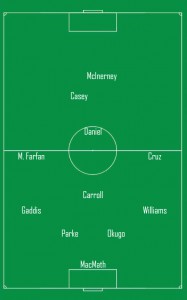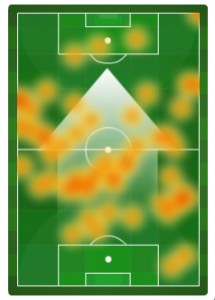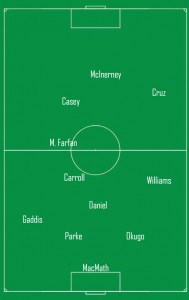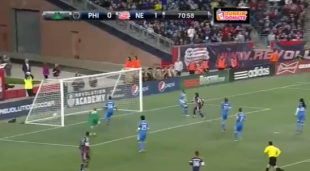And we are back to the question of identity.
Throughout the early success the Union were enjoying to begin 2013, the picture was growing clearer: This was not a possession team. Smart, composed build-ups did not matter as much as stout defense turned into speedy, hard-charging counterattacking play. Against Toronto and DC United, the Union conceded the possession battle by nearly a 2 to 1 margin in both matches, yet managed to scrape by with 4 points based almost entirely on the inspired tandem of Conor Casey and Jack McInerney.
As long as the Union could get a few chances each game, they seemed capable of scoring just enough to get by.
There’s a hole in the bucket
Against New England, Casey and McInerney cooled off and the bottom fell out.
In 8 matches thus far in 2013, the Union can claim 12 assists on their 10 goals. Five have come from the strikers and four have been attributed to the defense, while the unit charged with setting the table come in last with only three assists to go around.
It is no secret that in Major League Soccer, along with most leagues in the world, the team that controls the middle third of the pitch wins the majority of matches. For as much as commentators understate the difficulty of finishing, a soccer field is slanted towards the defense. To begin with, they tend to own a numerical advantage over the opposition’s strike force. Take a look at any weekend’s score sheets and the page will be replete with 1-0, 1-1 and 2-1 scorelines. In 2012, the average MLS match had 2.64 goals.
What does this mean for the Union? They must create. They must put an emphasis on creativity. And they must do it now. That means installing a full-time, attack-minded playmaker at the heart of the midfield. This is irrespective of the speed and aggression of the wide players and forwards. Without a creative fulcrum to link the fullbacks, wide midfielders and strikers, it does not matter whether the build-up is slow and methodical or an all out fast break; the attack will lack organization and will ultimately fail.
Entering each of their last three matches, the Union lined up against the bottom three team in the Eastern Conference. To gain only four points from those fixtures will not get the job of reaching the playoffs done, regardless of where those matches were played.
Back to the Bucket
Now back to the center of the midfield.
Specifically, the erratic play of Keon Daniel.
When Daniel took over from Michael Farfan in the center of the pitch, he ran as a CAM (central attacking midfielder). On paper, the 4-4-2 diamond made sense (figure 1). Though Daniel lacked ruthlessness in the box and struggled to pick out the final pass in the attacking third, he sat behind the strikers, pushing play.
In each match he has started, however, Daniel has dropped deeper and deeper, culminating in Saturday’s performance in which he spent considerable periods of play behind Brian Carroll. Confirmed by the heat map (figure 2), Daniel spend the majority of the match in his own half, where he was unable to influence positive play for his side.
Operating without an effective CAM was bad enough, but with Daniel sitting in Carroll’s preferred spot, the Union captain was forced to vacate his comfort zone, working wider and higher than he would prefer.
What about wingers?
With no attacking productivity coming from the center of the pitch, the Union’s wide midfielders, Michael Farfan and Danny Cruz, reacted in very different manners.
Playing on his off wing, Farfan turned in his best performance of the season, cutting into the attacking center of the pitch, eagerly consuming the gaping hole between Daniel, Carroll and the forwards. On the other flank, Cruz failed to adjust, continuing his one-dimensional approach to wide play by holding a high line, looking more like a winger in a three man forward line than a wide midfielder in a team struggling for possession. While his three midfield mates each completed 29 passes or more, Cruz finished with only 14. All but 3 came on back passes, with the majority of those coming after checking back from an advanced position.
That advanced positioning does not only have an effect on the midfield. Sheanon Williams’ early rough patch in 2013 was directly related to Cruz’s continued aggressive forward positioning. When Williams is at his best, the speedy fullback looks for a quick interplay of passes before racing down the touchline to run play into the corner. Without Cruz providing a consistent, easy outlet, Williams has been unable to keep in touch with the offense or sprint past his midfield partner on an overlapping run.
The resulting compromise is that Williams is forced to reside in a defensive no-man’s land, playing too high to cut off a diagonal ball in behind him, while still sitting too deep to catch up with Cruz on the breakout. Far from the typical 4-4-2 diamond, the Union’s alignment against New England took on a shape that defied tactical convention. (See image at left.)
Defensive deficiencies
The Union have conceded two goals in each the past two weeks against two sides that each had a total of two goals entering the match. That’s a lot of twos.
Considering how heavily the back four has been covering for their midfield teammates in 2013, it was inevitable that the pressure would get to them.
But fundamental cracks in the Union’s tactical approach have served to further pressurize the situation, making life even harder for the defense. As mentioned above, Williams’ tightwire act between fullback and midfield has created defensive problems on the right. Furthermore, with Amobi Okugo sliding wider than ever to help cover, the gap between him and Jeff Parke has become far too variable for comfort.
Given that Parke regularly provides extra cover for Ray Gaddis, who continues to struggle in the transition from right to left back, solid spacing between the centerback pairing has fallen off. Rather than assert their dominance on the midfield, beating their opponents back and allowing Okugo and Parke to find each other, Carroll and Daniel have funneled their way into the hole left at center defense.
No matter how talented a defense may be, if the opposition can walk the ball to within 35 yards of the goal in the attacking third, that defense will not only bend, they will break.
And thus the return to the midfield.
Fix the midfield and you fix the Union. Talented two-way players like the Farfan brothers (Michael not only led the Union with 43 passes completed, but he was also credited with an impressive 8 tackles won and 15 recoveries) can provide width in all three phases of play. Whether it is for Daniel or Carroll, Kleberson must be given the opportunity to prove that he can be the central offensive catalyst the Union so desperately need.
This week, player ratings will be separated into their own post to foster unique discussions pertaining to individual performances rather than the team’s performance as a sum of its parts.





fire our midfield into the sun
1) Good idea to separate analysis and ratings. Now we’ll have two articles in which to complain about the game!
2) This shit pisses me off so much. Its like watching your daughter get knocked up and agreeing to marry the father who she’s known for 2 weeks. Everything mentioned is not surprised in most of it is totally expected, yet Hackwork still trots out the same lineup and wants to act surprised it doesn’t work out.
It’s a one-time thing. The player ratings may be back in the same post next week. We’ll see how this goes.
After Hack entered the scene last year we ended up with something like 3 quick wins and then a whle bunch of losses after the opposition had figured out Hack’s strategy. Was obvious Hack had no B-plan… Unless he does this time, we could end up again with a whole bunch of losses after a good start!
I have mixed feelings about Gaddis, but let’s say you keep him at LB. You then have Garfan, Marfan, Kelberson and Torres available to play in the midfield. How you can play fewer than 3 of them is beyond me.
I would be happy to have Hack coach my son’s U-14 team, but what qualifies him to coach a professional side?
Toronto, DC, NE:
Three weak opponents, very similar Union tactics and execution in each match. The 1-1-1 record says more about the opponents than it does about the Union. Toronto had a sound, but ugly, strategy, and got their road point. DC were just not as good on that particular day, although on another day could have drawn or even won. NE simply played better and deserved their win.
Against better opposition, I don’t see the Union having any success at all with this lineup and these tactics.
I just can not believe all the ball watching that’s going on defensively; no one is picking up the runners! It is so basic that I just can not believe a professional team has such a weakness.
You have to cut the defense a little slack. Runners are coming from everywhere, unchecked. And they’re not running from 50 yards out. They’re running from 30. The defense is literally being overrun.
I agree but it happens on set pieces as well. No one is in charge back there.
Yeah. I’ve got nothing on that one. Why on earth was Ray Gaddis marking Jerry Bengtson on corners?!?
I saw that too. WHO’S IDEA WAS THAT?! Smallest guy on the pitch covering a lanky striker. Genius.
You should send figure 3 to Hackworth’s personal email address if you have it.
It looks like Brundlefly after going through the teleporter at the end of The Fly
My opinion is that none of the players with the exception of macinerny and macmath are actually committed to playing their position. It seems the other nine are so frustrated with the lack of offense and defense that the defense runs up on offense just to be caught out of position and the offense runs back onto defense to see possible chances ruined by lack of forward play and lots of failed passing in the center of the pitch. Gaddis gets left without cover when marfan comes inside so parke slides over to back him up then okugo backs up sheanon as he gets caught up the pitch artificailly creating defensive holes. Its like watching my kids u-8 teams midfield.
Also why on gods green earth is casey asked/feels the need to dribble around on the flank and try and cross it in. Thats not to his skill set. This all screams of a lack of cohesive coaching and commitment to a plan. Its pick-up play at its best.
A match I wish I could easily forget. Kleberson needs to start next week. Move Daniel back out wide or place him on the subs. His play as a CAM or box-to-box has regressed. Cruz and Williams are not connecting either. Fix those problems and the Mid will be stronger.
To put it simply…Hack over coaches this team. I don’t know how many times I have to say it, soccer coaches are called managers for a reason. The best ones are the ones who find a way to put their best players on the field and get them to play together well. Clearly Hack hasn’t gotten this memo.
I cannot understand why Hackworth keeps saying we need to get better but he’s not doing anything to help with that. It seems pretty clear to EVERYONE that a change of personnel would solve some issues immediately but he continues to trot out the same lineup. He said this was the team’s worst performance of the year – “by far” – so if he doesn’t make some sort of change for Saturday I’m gonna lose it.
Preferred:
MacMath
Williams – Parke – Okugo – Gaddis
Carroll (CDM)
Kleberson (CM)
Marfan – Garfan
Jack – Casey
Subs = Hoppenot, Le Toux, Daniel (not in order)
This is mine as well. But you know wish in one hand sh*t in the other and all
So the real question is was this game better or worse than the Colorodo game? I still think Colorado was wore painful to watch.